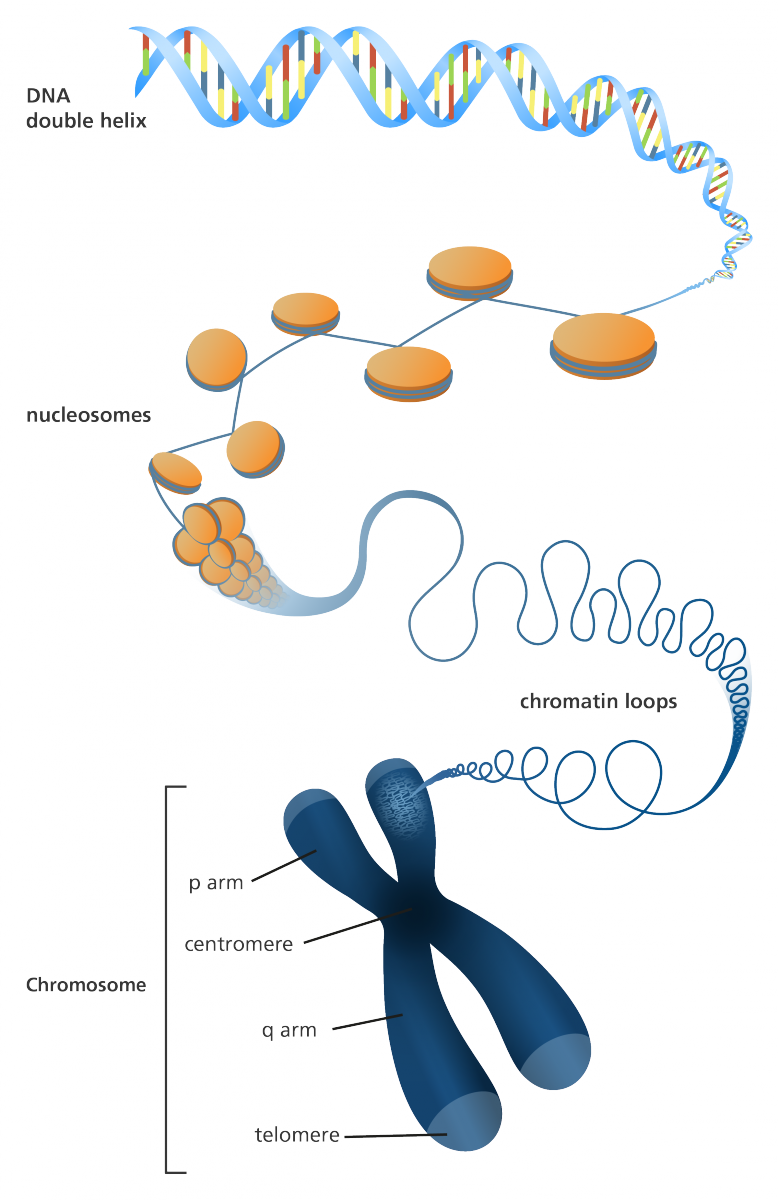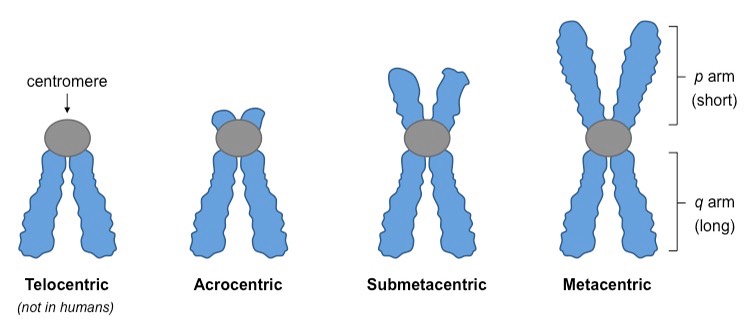Chromosomes Study Guide
Check out awesome, educational VR rooms on Inspirit’s mobile app (available for iOS and Android devices)🤩
Introduction:
The world of genetics is fascinating. The amount of information stored in a human body cell is marvelous. Everything is packed concisely and accurately within unique structures called chromosomes. These chromosomes are involved in cell division and replication.
The word chromosome comes from two Greek words. Chroma refers to the color, and Soma refers to the body observed. So chromosome was named so when it was observed as a colorful body under the microscope.
The genetic material which is a constituent of every cell is the chromosome. Each cell has a chromosome which is the coiled DNA, and Histone, which is tightly packed and arranged. These chromosomes carry all the information of the genetic traits of a cell. During reproduction, these traits get expressed. It is responsible for passing information about the body makeup to the child and also determines the intra and interspecies variation.
What are chromosomes?
Chromosome pairs are thread-like structures that human DNA makes. Deoxyribonucleic acid is responsible for the instructions which make a person’s genetic constitution unique. This is the basic chromosome definition.
These are found in the nucleus of the human cell and are the source of genetic information and carriers. They aren’t easily visible in a cell, and they can be observed under the microscope when cells are rapidly dividing. These chromosomes host all the genetic information. This genetic information is the particular trait each person inherits. This is responsible for variations amongst each individual.
Human chromosomes are found in the nucleus of the cells, and they can be identified and observed under the microscope when a cell undergoes division.
Work of chromosomes
Human Chromosomes are responsible for packaging human DNA, and it is an important contributor to the cell cycle and provides the relevant material to all the dividing cells. Any change in numbers and the structure of the chromosome can cause abnormalities. The human baby receives 1 copy of the chromosome each from the mother and father.
Different types of chromosomes
There are four major types of chromosome examples. These are divided based on the position of the centromere. These include metacentric chromosomes, submetacentric chromosomes, acrocentric chromosomes, and telocentric chromosomes.
- Metacentric chromosomes have the centromere located in the center, while submetacentric chromosomes have the centromere a little away from the center.
- Acrocentric chromosomes have the centromere visible from the center. This causes a very long and very short arm.
- In the telocentric chromosomes, the centromere is located towards the very end.
A chromosome is an answer to your question on how cells reproduce.
Fascinating facts about chromosomes
- Chromosomes are tightly packed DNA. When uncoiled, this DNA measures up to about 6 feet, along with the histones. It’s intriguing how efficiently the body stores it.
- Every organism has a different number and type of chromosomal DNA in its body.
- The 23 pairs of chromosomes have an X chromosome. This X chromosome is larger than the Y chromosome.
- The biological sex is determined by the chromosome acquired from the parent.
- It has been found that males have a higher X chromosome associated activity.
Chromosome and cell division
When a eukaryotic cell is preparing to divide, it produces a copy of every chromosome. These two copies of the chromosomes, called sister chromatids. Sister Chromatids are identical and are bound together by cohesive proteins. The centromere binds together both pairs of sister chromatids. When a cell undergoes division, these pairs split, and each cell receives one copy of these chromosomes.
Structure of chromosomes
Chromosomes, when observed under the microscope, can be shown having a central dividing unit called the centromere. From the centromere, two arms on each side are present, which are thread-like structures. These arms differ in their length. A distinguishing point used for chromosomes is the arms of the chromosome. The longer arm is called the “p arm,” and the shorter arm is called the“ q arm.’
Human chromosomes
Human beings are complex. It’s fascinating how 23 pairs of chromosomes make up the entire data of the body. Humans have 22 identical pairs of chromosomes. These are called Autosomes. The different pair of chromosomes in humans is the one that determines the biological sex of the baby. These chromosomes are called Allosomes. Males have an X and Y chromosome, and Females have both X chromosomes.
How are chromosomes made?
A chromosome is made when a DNA strand wraps multiple times around itself. It is held in place by a special protein called histone. The structure formed by these DNAs is called nucleosomes. Multiple nucleosomes coil up and make chromatin loops. These chromatin loops then combine and form the chromosomes that we see. These are elongated thread-like structures with a common center and 4 arms. In case you are wondering how many chromosomes humans have, it’s 23.
Chromosomal abnormalities
- Chromosomal abnormalities refer to the unwanted variation in the DNA during cell division.
- This causes several diseases and disorders. Aneuploidy and polyploidy are two common types of chromosomal abnormalities.
- In Aneuploidy, there is loss or gain of a pair of chromosomes which alters the normal number.
- In polyploidy, there is a gain of multiple sets of extra chromosomes.
- These abnormalities can cause Downs syndrome, Klinefelter syndrome as well as Turner’s syndrome. Alterations cause various other syndromes to chromosomes, which leads to multiple defects and deformities.
Down’s syndrome- It is caused by a gain of extra chromosome number 21. This leads to short stature, small head, and developmental issues.
Klinefelter syndrome- It is caused due to the presence of an extra Y chromosome, which causes sterility and feminine development in males.
Turner’s syndrome- It is caused due to the absence of one X chromosome. The twenty-third pair of chromosomes in half causes sterility and the absence of functioning ovaries.
Conclusion:
- Chromosomes are the genetic material responsible for different traits. It is transferred during cell division.
- Each cell has a chromosome which is the coiled DNA, and histone, which is tightly packed and arranged.
- These chromosomes carry all the information of the genetic traits of a cell.
- The chromosome is responsible for protein synthesis.
FAQs:
1. What are the 23 pairs of chromosomes?
Human genetic data is contained in 23 pairs of chromosomes, each of which is different in size and structure. The biggest chromosomes are the X and Y chromosomes, which constitute the 23rd pair of chromosomes, determine human biological sex.
2. What is a chromosome in the human body?
A chromosome is a storage and packed form of Human DNA.
3. What are chromosomes and their function?
Chromosomes are responsible for carrying genetic information and transferring it during cell division.
4. What do the 23 chromosomes represent?
The 23 chromosomes represent different traits of the human body.
5. How many gender forms or biological sexes do humans have?
Humans have two genders or biological sexes – Male and Female.
6. Can humans have 24 chromosomes?
Yes, it can happen because of a chromosome abnormality.
7. Which chromosome is responsible eye color?
Chromosome number 15
8. What happens when you have 47 chromosomes?
It can lead to trisomy, which can cause Down syndrome, Edward syndrome, and Patau syndrome.
9. What happens if you have 22 chromosomes?
This can cause chromosomal abnormality.
10. What is the role of chromosome 15?
Chromosome 15 is responsible for protein synthesis.
11. How many chromosomes do autistic humans have?
An extra stretch on chromosome number 22 contributes to autism. Otherwise, they have all 23 chromosome pairs.
We hope you enjoyed studying this lesson and learned something cool about Chromosomes! Join our Discord community to get any questions you may have answered and to engage with other students just like you! Don’t forget to download our App to experience our fun, VR classrooms – we promise, it makes studying much more fun! 😎
Sources:
- Chromosome. https://medlineplus.gov/ency/article/002327.htm#:~:text=Chromosomes%20are%20structures%20found%20in,exist%20in%20the%20proper%20form. Accessed 8 Dec, 2021.
- Chromosomes Fact Sheet. https://www.genome.gov/about-genomics/fact-sheets/Chromosomes-Fact-Sheet. Accessed 8 Dec, 2021.
- What is a chromosome?. https://www.yourgenome.org/facts/what-is-a-chromosome. Accessed 8 Dec, 2021.
- Chromosomes. https://flexbooks.ck12.org/cbook/ck-12-biology-flexbook-2.0/section/2.33/primary/lesson/chromosomes-bio/. Accessed 8 Dec, 2021.
- chromosome. https://www.cancer.gov/publications/dictionaries/cancer-terms/def/chromosome. Accessed 8 Dec, 2021.



